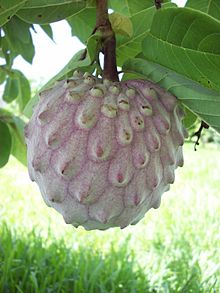Annona macroprophyllata
[2] John Donnell Smith, the American botanist who first formally described the species, named it after its large leaves (Latinized forms of Greek μακρός, makrós and φύλλον, phúllon).
[4][5] It is distinguished by its aromatic, pale-brownish-grey, furrowed bark and glossy, thin, elliptic to obovate or oblanceolate leaves, two to six inches (5.1 to 15.2 cm) long.
Clasping the base of the flowering branchlets are one or two leaf-like, nearly circular, glabrous bracts, about 1 to 1+3⁄8 inches (2.5 to 3.5 cm) in length.
[4] Fruit harvest of the ilama tree occurs in late June in Mexico, and only lasts about two weeks.
Bioactive molecules extracted from the leaves have been reported to have alpha-glucosidase inhibitor activity.
Generally, the ilama is covered with more-or-less pronounced, triangular lobules, though some fruits on the same tree may vary from bumpy to fairly smooth.
[8] The name is derived from the Nahuatl ilamatzapotl, of which the rough translation is "old woman's sapote".
The name is also applied to a similar fruit, soncoya or cabeza de negro (Annona purpurea).
It is sometimes served with cream and sugar to intensify the flavor, or with a drop of lime or lemon juice to highlight a tart and bitter note.
According to analyses made in El Salvador, the food value per 100 g of edible portion of the fruit is as follows: Francisco Hernandez was one of the first people to document the ilama.

